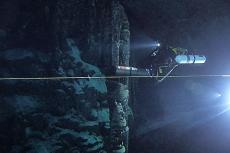Why Sidemount is My True DIR Diving Option
Doing something right has never been more important that being ready—and even eager—to change for the better. What was considered great a few years ago is not always great today. All we need is to find a better option, since what was right yesterday, may not be right anymore. Doing It Right (DIR) is about doing it better than it was done before. For me, that is the only right thing to do.
Ever since I can remember, two distinct parameters have pretty much ruled my entire learning life: common sense, and justifying anything that was being “fed” to me. These two “rules” basically determined my personal opinion on all things considered, whether it was diving or not.
Common sense began as my own “inner voice,” which helped me to understand and decide between a choice of two or more options at hand, even in the absence of history, experience and/or training. Eventually, it became the last check prior to making any decision—great or small.
Complex or basic, common sense has the ability to clear up the “silt” that confuses people when they simply do not know what to do. We are, for the most part, thinking beings, so as this is our primary tool, we should use it. Our brains work as a result of the synergy of two distinct stimuli: a) knowledge and experience, and b) common sense. These are the two factors behind our everyday decisions.
Justification is also crucial, not because I am a well-known reactionary person, but because I am also well known as a questioning person. Try to convince me that “your way” is right, and you will be bombarded with “why’s.” My main goal has always been to learn from any encounter. I do not argue, I do not disagree, I simply want to understand the reasoning of your proposed option. Questioning things is proven to create better learning, as through questioning, knowledge becomes not just a bunch of simply stated and accepted facts, but a familiar foundation, which is easier to remember and make one’s own. As you may have guessed, I was not meant for a military career.
This brings us to my actual career: diving.
History
In the 1990s, we saw the birth and rise of the “Doing it Right” DIR methodology in diving. A lot of good stuff came from it. However, the thought behind it basically “prohibited” any personal interpretation, making it inflexible but also non-evolving. The equipment that went with it, stemmed from its rigid mentality but was accepted because the system worked. It’s true; it did. But anything that works can evolve and work better. If nothing else, it is worth trying.
In the years that followed, two kinds of divers emerged: the ones who followed DIR, and the ones who almost purposely did things differently, just to make sure they were properly “outside” the DIR circle. The result was that neither of them evolved as much as they could have, given the years and number of practitioners involved.
The entire idea of DIR was amazing: Take only what you need, use these protocols and dive this way to be safe. It is true, a proper DIR diver is probably safer than the average diver when following DIR diving rules. The problem was that most DIR divers almost always just practiced their skills in order to be better, to be ready. Ready for what? I thought diving was supposed to be fun, too.
My journey through DIR diving was long, and exciting. That was probably when I also became a safe and aware diver. Just as the ad said: “Nothing was just because.” There was a justification for all of what we did. Except, there was one big issue for me: Years of boxing, as well as my shorter arms-to-torso ratio, made valve drills not only a pain, but straight up impossible with heavy undergarments. Of course, turning cylinders upside down or adding tools to help was a non-DIR process, and therefore prohibited.
Sidemount
Transitioning to sidemount came next, but not out of a trendy choice. There was no common sense for me to say NO to cylinders that were not connected by a manifold, but then need to basically un-gear in order to shut down my valves. Nowadays, out of pure personal challenge and some stretching, I have perfected back-mounted valve drills to my own level of perfection—though not suitable for a GUE training video. Still, I prefer to reach them easily, identify leaks faster and feel safer overall.
Once I started diving sidemount, I quickly saw a lot that DIR diving could have used from that system while remaining faithful to its holistic thinking and evolving. Though some great ideas like “donate what your breath” could stand in the way of progress.
DIR diving has a series of basic rules: Donate what you breathe, use a minimalistic approach, and dive as a team, are probably the cornerstones. Donating what you breathe is probably the only rule that sidemount actually fails to achieve on 50 percent of the dive. In real life, how many times have you actually had a need to share gas? I expect your answer to be (close to) “never,” if you are a proper and well-trained technical diver.
In sidemount, the chances that the regulator that I was breathing minutes ago will suddenly fail, or that the cylinder that is attached to it will be empty, are so small that it can be considered almost irrelevant. Not having to exit a cave “attached” to another diver when I can simply donate a cylinder, is more important.
Advantages
Sidemount is more trimmed than a back-mounted configuration. That is a fact when divers use just two cylinders, but it is even more obvious when additional cylinders are used. With all the focus on keeping everything from hanging so as not to create an entanglement issue, seeing experienced back-mounted divers, myself included, was not pretty, and often made no sense. Having hanging or floating cylinders when empty, is now something I have a hard time comprehending. Why not look towards sidemount when rigging and preparing stage cylinders? What was the downside of that? Nothing. It was simply the rejection of progress, especially when it came from the “other” (non-DIR) side of diving.
Sidemount is a more personalized configuration than backmount. Does it make sense for someone like me who measures 170cm of height to use the same setup and rigging distances that a two-meter giant uses? Why was this never considered? At the end of the day, as technical divers, we all have our own equipment. The problem is that we are not all the same size.
When it came to stage cylinders, for example, I do not recall anyone considering the distance to the back clip. Why didn’t we learn from sidemount, which relatively early on produced a very nice, tidy and yes, a “right” position for their side-mounted cylinders? Why didn’t we think we could do that for our stage cylinders? Why didn’t organizations that teach both DIR (or Hogarthian) style technical diving and sidemount think of merging the good from both sides?
Approach
I still believe that the DIR approach is an awesome way to conduct technical diving. Learning the fundamentals is paramount prior to moving in the direction of technical diving. Be in control. Plan your dive with knowledge and execute it with ease and awareness.
But you should also consider your own uniqueness, your own highs and lows. With these in mind, create your own “DIR” version. What is “right” for me may be impossible or simply challenging to you.
And regarding team diving, as long as we all know what we have to do if an emergency occurs, and we have practiced it together, then we are a team. Reducing response options has proven to reduce stress and reaction time when solving a problem. But making the selected options easy is important too. I know divers who avoid difficult-to-do exercises. As a result, once they get certified, they never practice those emergency scenarios again. Even if there is only one option, it is as far as it can be from being a comfortable and effective one.
Personally, I was one of those divers who avoided skills that reminded me of the difficulty in reaching my valves. Not anymore. I practice valve drills prior to any serious dive, on all cylinders (sometimes up to five in a single dive). Yes, in sidemount, it takes time and commitment when it comes to rigging equipment properly. It is far more personalized, and a 3cm distance longer or shorter can dramatically change how you feel. However, once I am done, it is truly done “right” for me. Everything is tight, close by and has a reason. It has a justification. It has common sense.
I think sidemount is the future of the true DIR diving. Most of its practitioners develop their own adaptations on established standards and share them openly. Most importantly, equipment companies often listen to and adapt their next products for these real needs and/or solutions. They listen to real divers. They evolve.
A sidemount diver is not necessarily a more evolved diver, but the holistic minimalism and safe practice of the DIR principles, which we all loved, are still there. Each year they become better. ■
Stratis Kas is a professional award-winning photographer, filmmaker, trimix, cave and DPV instructor and is the co-author of cave diving manuals, exams and related materials. Widely published in international magazines like Vogue (Italy, Russia, Greece) and GQ (UK), his images have been exhibited in London, New York and Paris, and have been used by brands such Christian Dior and Levi’s. Diving since 2001, Kas has truly global experience in diving, from South America to Hawaii, from high-altitude lakes and Florida caves in the United States to the Red Sea and beyond. Since 2016, Kas has led the Top2bottom cave-filming team, which specializes in adventure film. In 2017, he finished his first film, Amphitrite, which won a finalist place in the SHORT to the Point international short film festival in 2018. Currently, he is filming his first full-feature film, Echoes of Silence, produced by Because I Can, Ltd., and FilmO2 Paris.
Download the full article ⬇︎












